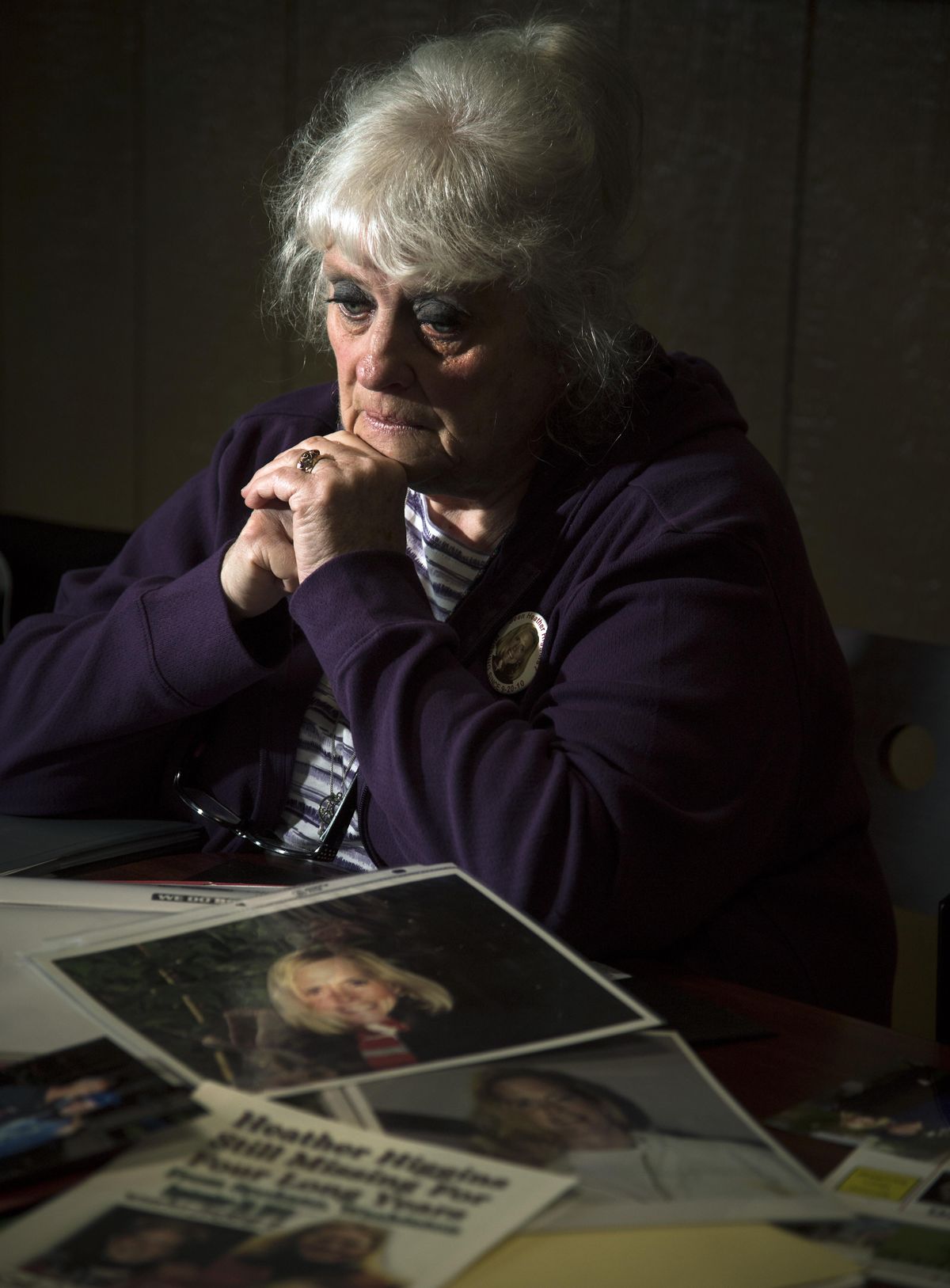The deaths of two Spokane women touch three mothers, who ask why a primary suspect hasn’t been charged

Three Spokane-area mothers are haunted by missing person reports, cause-of-death rulings and unsolved crimes. They are three mothers bonded by pain.
One has a daughter who was found cut in half in 2012. The second mother’s daughter went missing in 2010 and is believed to have met the same fate, but she has never been found. And the third mother wants justice for the other two, even though her son is the suspect in both cases.
While the three have never met, they all know each others’ stories. They all believe Spokane police should have done more, sooner, to solve these crimes, and they all believe Spokane County Medical Examiner Dr. John Howard has hurt their quests for justice.
“I had a daughter missing for 24 hours. I almost lost my mind,” said Sherri Cook, mother of convicted felon and murder suspect Robert G. Davis. “I can’t imagine what Heather’s mother is going through or Kala’s. I would just want to hug them and cry with them.”
Kala Williams, 20, was found on May 13, 2012, two days before her mother’s birthday. She had been cut in two, her lower half stuffed into a sleeping bag and covered with debris near 14th Avenue and Lindeke Street.
Investigators found DNA on Williams’ badly decomposed body that was a match to Davis. Yet investigators, citing an “undetermined” manner of death ruling by Howard in court records, have never charged him.
“It was so obvious that it was a homicide that the detective hired a different coroner to examine the body,” said Williams’ mother, Martine Maggio, of Spokane. “They found DNA evidence under her fingernails and defensive marks. Why does it take so long” for charges to be filed? she asked. “They wait so long that it almost becomes a cold case.”
Maggio was told that Cook also wants closure, even though it could mean more prison time for her 47-year-old son. He is serving time in an Idaho prison following a 2014 attack in which he twice choked a Coeur d’Alene woman to unconsciousness before she was saved by her dog.
“I would hate to be her,” Maggio said of Cook. “That would be very disturbing to me to know that my child ended the lives of others. I’m very proud of (Cook) that she is coming forward and that she wants justice just as much as the mothers of the victims.”
Jackie Forney, of Clayton, Washington, has books listing dates and calendar notes that mark the years she has searched in vain for her daughter, Heather Higgins, who was 39 when she was last seen on Sept. 20, 2010. She disappeared after accepting a ride from Davis.
During Forney’s frantic search and sleepless nights, the desperate mother and another member of the family even attempted to barge into a Spokane drug house in October 2012 after she received a tip that users had taken Higgins hostage and were torturing her.
What Forney didn’t know at the time was that Cook had told Spokane police detectives earlier in 2012 that Davis claimed to have helped dispose of Higgins’s body in “sleeping bags” somewhere on a steep embankment north of Spokane.
Detectives didn’t tell Forney they had information her daughter was dead until three years later – in 2015.
“I still thought my daughter was maybe alive. I was following all kinds of tips,” Forney said through tears. “At that time (2015), I realized my daughter was gone. In a way, it set me free. I no longer had to look at dead bodies.
“Every time they would find a dead body in Spokane, I’d go into hysterics thinking it was going to be her. I think (detectives) should tell parents when they find out stuff, so parents are not out there looking for nothing. It’s sure destroyed my life.”
Manner of death questioned
In May 2012, Forney remembered seeing media reports of a body found in a wooded area near 14th and Lindeke.
“I was so sure it was going to be Heather. I went and cleaned the front porch, because I knew the police would be coming by,” Forney said. But the body wasn’t her daughter. It was 20-year-old Kala Williams.
The body had been cut into two sections and placed in bags. Tests were done on underwear found in the sleeping bag, on material under Williams’ fingernails and on black electrical tape wrapped around Williams’ neck. All came back as DNA matches to Davis.
Despite descriptions in court documents of defensive cuts on her hands and the bisection of the body, Howard ruled that the manner of death was undetermined. Spokane police Detective Mark Burbridge later ordered another medical review of the body, which found more than 60 additional wounds unlisted in Howard’s report. The second medical expert, Dr. Carl Wigren, said the death clearly appeared to be a homicide.
Wigren “is not an appointed medical examiner,” Medical Examiner Dr. Sally Aiken wrote in a written response to questions. She said Howard, with whom she shares the title of medical examiner in alternating years, considered Wigren’s findings but “has not changed his opinion as to the cause and manner of death.”
Maggio, Williams’ mother, said she also spoke with Howard in 2012 about his cause-of-death determination.
“I asked him at the time, ‘If it was your daughter who was found in this manner … She didn’t cut herself up; she didn’t wrap herself up. It’s obviously a homicide,’” Maggio said. “Howard said, ‘Ma’am, the person who did these things and wrapped her up is not necessarily the person who killed her.’
“I was furious over that comment. But, we were still nice and polite and tactful, but it just didn’t get us anywhere.”
In court records, Burbridge noted Howard believed Williams may have died from a methamphetamine overdose, although the drug levels found in Williams (0.15 mg/L) were about six times lower than what he considered a lethal dose of the drug.
Cook, Davis’ mother, also reacted angrily when she learned that Howard cited the drugs in Williams’ system as a possible cause of death.
“It seems like this coroner feels like they deserve it if you are doing drugs,” Cook said. “That’s absolutely horrible. He jeopardizes cases. He should not have that job, in my opinion.”
Forney said she learned about Howard’s inconclusive manner-of-death ruling just last month, nearly five years after Williams’ body was discovered. She was provided court records in March.
“I think that it’s appalling that he could come up with that answer,” Forney said of Howard. “It looks as though he didn’t put all the findings in the report.”
Forney had plenty of issues with how Burbridge handled the search for her daughter, but she noted that at least Burbridge tried to persuade prosecutors to file charges in the death of Kala Williams.
“I think the medical examiner is the problem here,” Forney said. “If he slowed down the process after Kala, then the next victim is on his hands.”
Davis remained free as Spokane law enforcement officials pondered how to proceed in the Williams case. While out of custody, he attacked the Coeur d’Alene woman in 2014 and was subsequently arrested.
Davis was convicted in Kootenai County of burglary and assault with sexual motivation. Although he was sentenced to 15 years in prison, Davis will be eligible for parole in June 2018.
He has yet to respond to a Spokesman-Review request for an interview from an Idaho state prison in Boise.
Circling crime spree
While Williams’ family continues to seek justice, Forney is left wondering what happened to her daughter.
“The police department is the second-most-important agency in our lives. They really do good and protect us,” Forney said. “They really are heroes.”
However, she believes that if Spokane police detectives had started sooner in 2010 to try to find Heather Higgins, Kala Williams might be alive and the Coeur d’Alene woman would not have been attacked in 2014.
She said it took the Spokane police two weeks to assign a detective to look for Higgins after Forney reported her missing on Sept. 27, 2010.
Forney gave Detective Tim Madsen a selection of photographs to use, including a recent photo of Higgins taken after she graduated with honors from Spokane Community College.
But instead, Madsen used Higgins’ DUI arrest mug shot in a news release issued in November 2010 seeking public help to find Higgins. In the news release, Madsen noted that Higgins was bipolar, “possibly an alcoholic” and had two misdemeanor warrants for her arrest.
“This drags up a lot of anger,” Forney said. “I spent the whole rest of my time trying to uplift her name so they would care and help find her.”
Spokane police Capt. Brad Arleth and Major Crimes Lt. Steve Wohl said Madsen no longer works for the department. But they agreed the department should have done more sooner to help find Higgins.
“I wish the department had taken a quicker look at her missing-person status,” Arleth said. “There is no other way around this.”
He noted that in the vast majority of missing person cases, the person reported missing is actually trying to avoid or escape the person making the report. But changes have been instituted since the Higgins case to try to avoid a similar outcome.
“I’m not trying to make excuses by way of explanation,” Arleth said. “But we have a completely different set of communication loops in place. I feel comfortable that we wouldn’t experience the same delays at this time.”
After Higgins first went missing, Forney asked friends and neighbors what they knew, and she pieced together her daughter’s last known hours. She reported her discoveries about Davis to the detectives.
Higgins, 39, was enrolled as a student at Eastern Washington University. While she always paid her rent, she had bipolar disorder. About two weeks before she went missing, Higgins had a bad episode that required her to be hospitalized.
Higgins had planned to move to a new apartment. All of her belongings were boxed, and she obtained the cash needed for first- and last-month’s rent. But after she was discharged from the hospital, Higgins returned home to find that someone had broken into her apartment and stolen the cash, Forney said.
Desperate to keep the rental agreement intact, Higgins needed a ride to her bank to see if she could get a loan to tide her over until her next paycheck. She also told a friend she could hock some rings at a pawn shop. She walked across the street to an apartment complex and asked a neighbor if she knew anyone who could give her a ride.
Unbeknownst to Higgins, the female neighbor, Dawn Sandell, had reported in 2007 to Spokane police that she had been choked unconscious and raped by a man named Robert G. Davis.
That case was investigated as a first-degree rape, but it wasn’t forwarded to prosecutors until 2013, Wohl said. Prosecutors have never filed formal charges.
But in 2010 when Higgins asked Sandell for someone who might give her a ride, Sandell gave her Davis’ name and number, police confirmed. Davis arrived that day in a blue minivan with fake wood paneling on the sides. Higgins was never seen again.
Sandell did not respond to an April 21 request for an interview, and it is unknown why she gave Davis’ number to Higgins. According to a Facebook post by her son, Sandell died April 25. She was 47. Her cause of death remains undetermined pending toxicology results.
After Higgins’ disappearance, Forney learned in February 2011 that detectives spoke to Davis about Higgins. He admitted giving Higgins a ride to her bank. But Davis claimed that Higgins became upset and that he left her there.
At the same time, the detectives asked Davis about his minivan. He told them that he had sold it in December 2011 and it had been crushed at a wrecking yard, Forney said.
The investigation “just kind of dropped right there,” she said.
Detectives never told Forney that on Aug. 28, 2011, a man was wading in the Spokane River near Elm Street and Main Avenue when he picked up a rock and found an EWU student ID card for “Heather Higgins” next to a butcher knife. The items were found 3 1/2 blocks from where Davis had been living.
After Williams was found dead in 2012, Cook came forward and told detectives how her son, Davis, claimed to have helped dispose of Higgins’ body in 2010.
Then in 2016, the Higgins case was assigned to a new police detective, Paul Lebsock. Forney said he remembered the detail of how Higgins said she had rings to hock. Police officials confirmed that Lebsock checked records at local pawn shops and discovered that Davis hocked six rings the day after Higgins disappeared.
One of the rings bore a distinctive pattern. “It was my mother’s ring,” Forney said. “Nobody checked the pawn shops for five-and-a-half years?”
Angry red scars
A dog mauled Robert Davis’ face when he was 3. The dog actually ate part of his cheek, leading to several reconstructive surgeries that left him with permanent scars, Cook said.
The scars caused a speech impediment. Teachers wouldn’t call on him in class. Students never let him forget.
“He was angry. It had a great effect on how he dealt with other people,” Cook said. “His scars get red when he gets angry or his blood pressure rises.”
Davis started using drugs and showed symptoms of mental health problems. Cook said she tried to get help for him many times, but he would often slip away at the last second.
Cook said she remembered her son coming home in 2010 after years of drug use and living on the street. He was distraught. Cook said it took her two days to calm him down enough to get him to tell her what happened.
“He kept saying, ‘I did something bad. I did something bad,’” Cook said. “I said, ‘Son, tell me what you did. We can work through this.’ It took a lot of pressure before he broke down and told me about Heather.”
Davis told his mother that two men threatened to kill her and his sister if he ever told anyone what he did. Davis eventually told Cook that two men killed Heather Higgins and “they forced him to dispose of the body. He said he rolled her off a cliff, but she got hung up in the trees,” Cook said.
She remembered that Davis said he put Higgins in two sleeping bags to dispose of her body in 2010. The location was somewhere north of town on the way to a ski resort.
“I didn’t say anything back then, because he was doing drugs,” Cook said. “I didn’t know (if) what he said was truth or imagined. Heather’s mother will wonder why I didn’t speak up sooner. That’s why. He was a babbling drug addict. At what point do you take him seriously?”
But Cook reached out to detectives after she heard about Kala Williams two years later. She learned Williams’ body was cut in half and part of it placed into a sleeping bag.
“The body was close to where he camped. The sleeping bag was stolen from here,” Cook said. “His underwear was at the bottom of the sleeping bag. Now we have more than the ramblings of a drug addict. We have facts. Now I have to say something.
“I decided I have to let someone know, especially the sleeping bag part,” she said. “That is etched into my memory … even if you suspect your son is delusional.”
Cook said detectives asked her not to reach out to Forney, who didn’t learn of Davis’ story of helping get rid of Higgins’ body until 2015.
“They were not ready to let Heather’s family know she was deceased,” Cook said of the detectives. “So, this mother keeps looking for her daughter with no answers? But I complied. I didn’t want to add hurt where there is already hurt.”
Forney wears that hurt on her face and through her tears whenever she talks about all the empty nights she spent worrying that her daughter was in pain.
“I feel kind of lost without her,” Forney said.
Though she did not know the full extent of Davis’ alleged involvement in her daughter’s death in 2014, Forney nevertheless knew his name from the investigation, and attended the Coeur d’Alene sentencing stemming from his most recent attack. It was only then that she learned from a prosecutor that Davis was a suspect in the death of Williams.
“I had never seen him before,” Forney said. When the Coeur d’Alene victim walked into the courtroom, Davis’ “face went bright red. It made the hair stand up on my neck.”
The victim shook on the witness stand as she explained to the judge how she thought she was going to die. Afterward, Forney approached the terrified victim, introduced herself and told her about Heather.
“I told her, ‘Because of your bravery, you saved the next one,’” Forney said. “She just turned white.”

